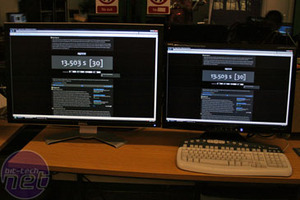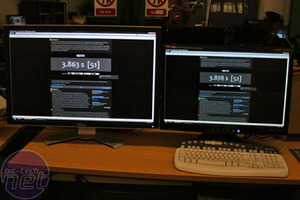
Next, watch the video below: what you’re looking at is the Samsung 244T running in extended desktop mode next to the Dell 3007WFP. A window is positioned to straddle the gap between the two panels.
As the window is jostled up and down, the 244T’s appears to respond to input slower than it does on the 3007WFP. It’s just visible to the naked eye, but very obvious when you see it in slow motion. Again, the video then shows the twin Dells completing the same task, but this time both halves of the window move as one.
In our experience, a gap of anything more than around 20ms compared with a low lag monitor like the Dell 3007WFP – which itself lags by about 10ms compared to a CRT monitor – is noticeable to the user. And that includes nearly all PVA based monitors currently available. All of Dell’s 24-inch PVA widescreen monitors, starting with the 2405FPW through the current 2408WFP suffer from noticeable lag.
Samsung’s current 24-inch premium panel, the SyncMaster 245T, is less laggy than its predecessor (the infamous 244T), but it still clocks in around 25 to 30ms slower than the Dell 3007WFP. Sadly, that’s about as good as it gets for overdriven PVA panels. To date, we’ve yet to test an overdriven PVA panel with significantly less than around 25ms of lag compared to a low lag panel like the 3007.
There is a light at the end of the tunnel though, as there is some evidence that manufacturers are finally getting to grips with input lag. NEC's MultiSync LCD24WMGX3, a 24-inch monitor with an MVA panel, curiously introduces what NEC calls a ‘Through Mode’, which supposedly sidesteps all the image processing circuitry and therefore ‘shortens the delay time of the picture signals within the monitor.’
Knowing that the Dell 3007WFP is a fairly lag-free monitor, we set about putting this feature to the test and, pleasingly, the operating mode appears to work fairly well. We first tested the LCD24WMGX3 with Through Mode disabled and found that NEC's display had little or no more lag than our Dell 3007WFP, but after switching Through Mode on, we found that the WMGX3 actually had virtually no input lag at all. It ended up around 10 to 15ms faster than the Dell across multiple systems and when you factor in the 3007WFP lags behind a CRT by approximately 10ms, that equates to no lag.
Moreover, after testing how image quality was affected when Through Mode is enabled, we found that the differences were too small to make out or there simply weren't any differences – at least in sRGB mode. This was pleasing to see, but it looks like we've got to wait a little longer for other monitor manufacturers to recognise the problem and come up with their own ways around it.
As we’ve proven, input lag is real enough. Is it, however, something that will actually bother you? It’s impossible for us to say, as it is something that – as you can see from forum discussions – intensely irritates some, while is all but invisible to others. It is real though, and if fast paced gaming is one of your core computing activities and you’re considering buying a PVA monitor, you owe it to yourself to try before you buy if at all possible. It could save you a lot of time, money and disappointment.
As the window is jostled up and down, the 244T’s appears to respond to input slower than it does on the 3007WFP. It’s just visible to the naked eye, but very obvious when you see it in slow motion. Again, the video then shows the twin Dells completing the same task, but this time both halves of the window move as one.
In our experience, a gap of anything more than around 20ms compared with a low lag monitor like the Dell 3007WFP – which itself lags by about 10ms compared to a CRT monitor – is noticeable to the user. And that includes nearly all PVA based monitors currently available. All of Dell’s 24-inch PVA widescreen monitors, starting with the 2405FPW through the current 2408WFP suffer from noticeable lag.
Samsung’s current 24-inch premium panel, the SyncMaster 245T, is less laggy than its predecessor (the infamous 244T), but it still clocks in around 25 to 30ms slower than the Dell 3007WFP. Sadly, that’s about as good as it gets for overdriven PVA panels. To date, we’ve yet to test an overdriven PVA panel with significantly less than around 25ms of lag compared to a low lag panel like the 3007.
There is a light at the end of the tunnel though, as there is some evidence that manufacturers are finally getting to grips with input lag. NEC's MultiSync LCD24WMGX3, a 24-inch monitor with an MVA panel, curiously introduces what NEC calls a ‘Through Mode’, which supposedly sidesteps all the image processing circuitry and therefore ‘shortens the delay time of the picture signals within the monitor.’
Knowing that the Dell 3007WFP is a fairly lag-free monitor, we set about putting this feature to the test and, pleasingly, the operating mode appears to work fairly well. We first tested the LCD24WMGX3 with Through Mode disabled and found that NEC's display had little or no more lag than our Dell 3007WFP, but after switching Through Mode on, we found that the WMGX3 actually had virtually no input lag at all. It ended up around 10 to 15ms faster than the Dell across multiple systems and when you factor in the 3007WFP lags behind a CRT by approximately 10ms, that equates to no lag.
Moreover, after testing how image quality was affected when Through Mode is enabled, we found that the differences were too small to make out or there simply weren't any differences – at least in sRGB mode. This was pleasing to see, but it looks like we've got to wait a little longer for other monitor manufacturers to recognise the problem and come up with their own ways around it.
As we’ve proven, input lag is real enough. Is it, however, something that will actually bother you? It’s impossible for us to say, as it is something that – as you can see from forum discussions – intensely irritates some, while is all but invisible to others. It is real though, and if fast paced gaming is one of your core computing activities and you’re considering buying a PVA monitor, you owe it to yourself to try before you buy if at all possible. It could save you a lot of time, money and disappointment.

MSI MPG Velox 100R Chassis Review
October 14 2021 | 15:04










Want to comment? Please log in.